

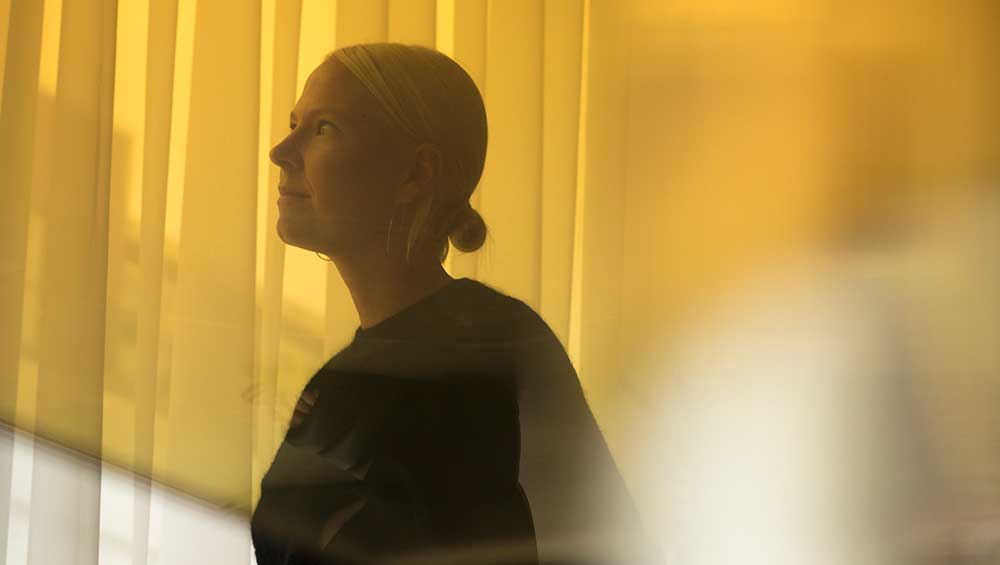
Sabine Marcelis. Photo: Cleo Goossens.
by NICOLA HOMER
Sabine Marcelis makes collectable design objects. The Dutch designer runs her studio from the harbour at Rotterdam. She was born and grew up in New Zealand and studied industrial design at Victoria University in Wellington before moving to the Design Academy Eindhoven, from which she graduated in 2011. Marcelis has established a name for herself by making beautiful objects in glass and cast resin, such as her elegant series of resin fountains for the Italian fashion brand Fendi’s booth at Design Miami in 2018. The following year, she channelled the spirit of modernist architecture at her solo show, held in collaboration with the Side Gallery at the Mies van der Rohe Barcelona Pavilion, originally built in 1929 as the German national pavilion at the city’s international exhibition. Now, she is bringing a sense of fun and a splash of colour to St Giles Square, at the foot of the brutalist Centre Point tower in London. The concept of colour is key to understanding the designer’s presentation at the Vitra Schaudepot, which shines a fresh light on the collection of the Vitra Design Museum in Germany.
Studio International spoke by phone to Marcelis at her studio in Rotterdam. The following is an edited extract of that interview.
Nicola Homer: How did you get started in the world of design?
Sabine Marcelis: I’ve always been curious for lots of rich and interesting experiences. My parents really encouraged creativity, so I have been very creative from a young age, but not necessarily knowing what I wanted to be when I was older. I’m a very passionate person. My first big passion was snowboarding, so I spent a lot of years doing that. Then when I was 21, I decided I should probably go and study something. So, I went and studied industrial design in New Zealand, where I was living, and I really enjoyed that. I then transferred to Eindhoven to finish my studies at the Design Academy, where there was a bit more freedom in conceptual thinking and following your fascination, so it wasn’t so much about designing for industrial processes or optimising for mass production the same way it was in New Zealand.
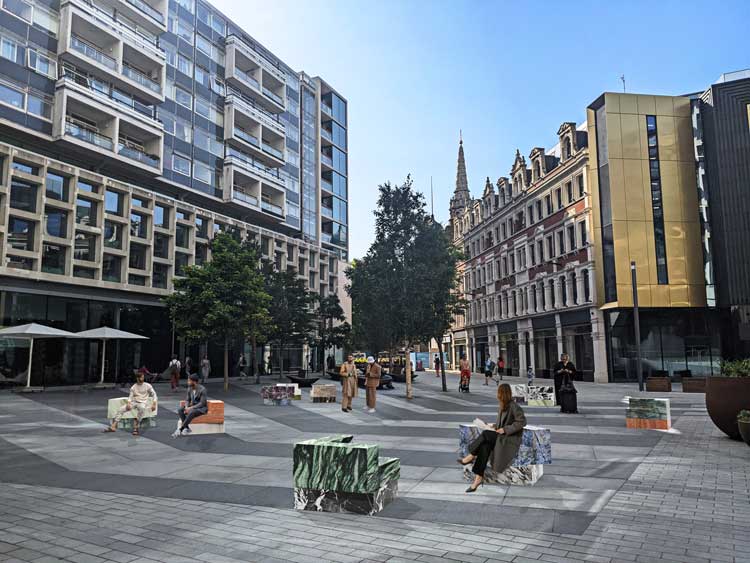
Sabine Marcelis, Swivel, 2022. Visual of site, Centre Point, St Giles Square, London. Courtesy of Studio Sabine Marcelis.
I was more able to cultivate my own vision of design in the Netherlands. I homed in on what I found interesting about design, which is what machines can do, such as how do you work with production processes to get the most out of materials. Having grown up in nature and spent so much time in the snow above the clouds, where it’s the most amazing light, I love light, and I love to play with light. I wanted to capture those moments in nature within design and I was able to explore that further in the Netherlands. I graduated with an installation to make wine at home, which really celebrated the changes that the material goes through as it goes from a liquid that is fermenting and there are bubbles. I wanted to showcase those changes.
NH: Where was home for you in New Zealand?
SM: I grew up in Waihi, which is in the Coromandel, in the North Island. Then I went to high school in Wānaka, a ski resort town in the South Island. The school was very outdoor-focused, so we had a lot of outdoor activities instead of other subjects. We did rock-climbing, snowboarding and kayaking instead of other subjects.
NH: Who or what are your sources of inspiration? Would you agree that nature is a source of inspiration for you?
SM: Yes, 100%. It’s an endless source of inspiration. It’s very cliched but I think it’s amazing that every time I go outside, there are all these little details; at the moment, it is so cold in the Netherlands and the frost is sitting on the leaves, there’s so much beauty to be found. Things that happen in nature, little moments, the way that light bounces off the water, all these things can be a starting point for wanting to capture that in an object or an installation. At the same time, being in factories is a huge inspiration for me, and understanding how materials are processed through machines. For many years, I’ve been working with two main materials, cast resin and glass. I have a lot of knowledge about how to process those materials, and still with each project we learn something new, or we try to push it a bit further, which can then inform the project after that. To keep building on those production processes is hugely inspiring for me as well.
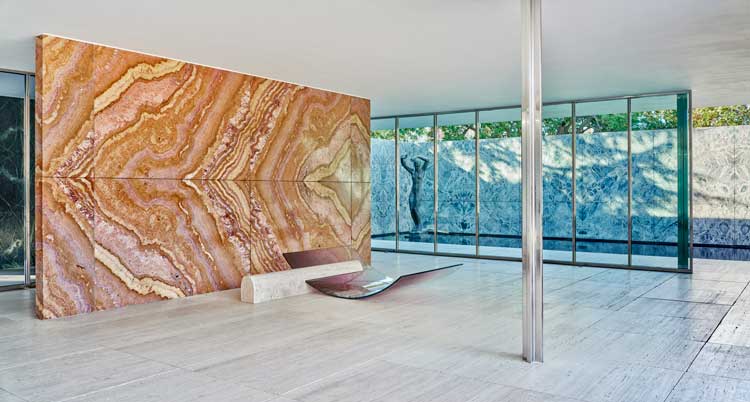
Sabine Marcelis, No Fear of Glass, 2020, installation view, Mies van der Rohe Pavilion, Barcelona. Courtesy of Studio Sabine Marcelis.
NH: That’s brilliant. Could we talk about an example of that? How did you push the boundaries of materiality in your exhibition at the Mies van der Rohe pavilion in Barcelona, entitled No Fear of Glass, a solo show in collaboration with the Side Gallery in 2019?
SM: That was a dream project for me because it’s such an amazing space, and very complete in how it is. It doesn’t need additional work from me. It was daunting to work on those pieces, because I wanted them to complement the space and not to feel like alien objects that were just plonked down in there. I very much approached that project from the materiality of the pavilion, and I wanted to create objects that were taken from the architecture, extruding the materiality. For example, there are a couple of chaises longues in the interior part of the pavilion, which are designed in a way in which it feels as if the travertine floor has been pulled up, and then you have this glass in the colour of the onyx, the marble that the pavilion is made of, and it’s pulled out of that wall, and it cuts through the travertine base to become a functional object.
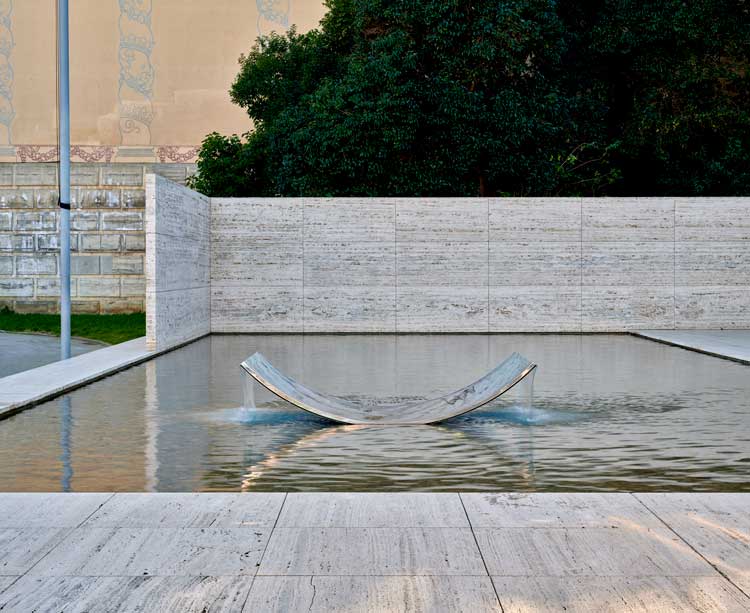
Sabine Marcelis, No Fear of Glass, 2020, installation view, Mies van der Rohe Pavilion, Barcelona. Courtesy of Studio Sabine Marcelis.
Because the scale of the pavilion is so big, these objects needed to be bigger to make sense in that space. So, the chaises longues were made using enormous pieces of curved glass, and that was very challenging. I had to travel across Europe to find a production partner willing to tackle that problem with me, and I think especially the problem of the fountain. I wanted to treat the water of the pavilion as a material, extruding it, pulling it up inside the curved glass, and then letting it overflow. I think it’s also something that I use as a way to trick myself into realising projects because I make a design and then we have to figure out how to make that a reality. So, it’s like, OK, we have to make it work because everyone’s expecting this to be there at a certain deadline. It’s a really interesting challenge and I get a rush of adrenaline from trying to make the impossible happen. That fountain gave me a lot of sleepless nights over how to make it work. But we did it and now I feel very confident in working with curved glass at these scales. The next project in which we apply that production process won’t be such a crazy feat. Then we can try something even crazier on top of it.
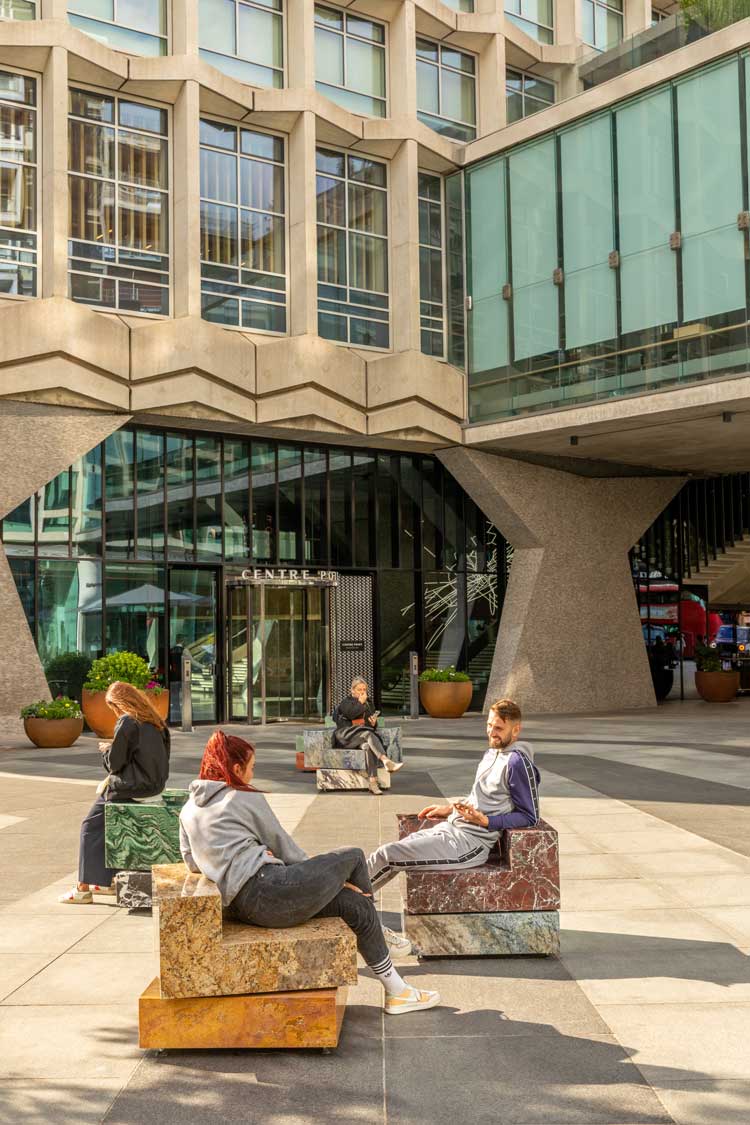
Sabine Marcelis, Swivel, 2022. Rotating stone chairs, installation view, Centre Point, St Giles Square, London. Photo: Ed Reeves.
NH: Could you talk about how you continue to explore themes of materiality and movement in your installation for St Giles Square at the foot of Centre Point in London, in a space used by the public?
SM: That was a commission initially from [the property investment and development company] Almacantar for the 2022 London Design Festival, but it has decided to keep it there. It was a similar approach. When I work with an existing site or a site-specific location, I find it crucial to work with the surroundings and have that inform what the object or installation is going to be. The main feeling I got when I visited the site was that it was very grey and cold, with not a lot of colour, and no invitation to take a moment to rest or to stop at that square, even though it’s very central. It should be a place where you can take a moment. There was no interaction with people, even though it is a high-circulation zone.
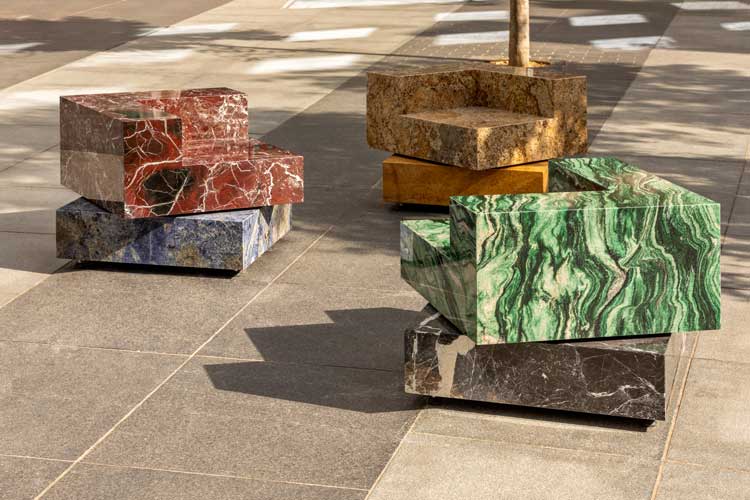
Sabine Marcelis, Swivel, 2022. Rotating stone chairs, installation view, Centre Point, St Giles Square, London. Photo: Ed Reeves.
Three roads are connected through that square, so people are walking into it all day long. I wanted to inject a bit of fun and colour and encourage some interaction with people in that location. In contrast to the brutalist architecture, all the sober, grey, cold colours of the man-made buildings in the square, I chose to juxtapose unexpected, super-bright colours that nature creates in marble or natural materials. There are 10 swivelling marble chairs. It was very rewarding because often I don’t see where my work ends up or how people interact with it. But even during the installation of these pieces, people were jumping on them and moving and enjoying them. It made me want to do more of that.
NH: That’s such a positive perspective. Now, I’d like to focus on Colour Rush!, your current exhibition at the Vitra Design Museum, where I understand you have transformed the space of the Schaudepot by curating about 400 exhibition objects by colour. The museum’s website describes it as “an homage to the role of colour in design across all periods and styles”, noted for its “immersive experience”. How did you create that immersive experience?
SM: The Vitra Design Museum has this huge collection of design, more than 700 pieces, but they have always shown just the highlights or the most well-known pieces in a chronological manner. It’s a very beautifully designed space by Herzog & de Meuron. I always enjoy going there. It’s like a walk through time. When I was asked to reimagine how that collection could be presented – I’m just a fan of making singular bold statements – so I thought it would be really interesting to strip all these objects of any date and relevance, and just categorise them together by colour. In that way, you also create new relationships between objects, where you have something that was from the 18th century placed next to something from the 1970s.
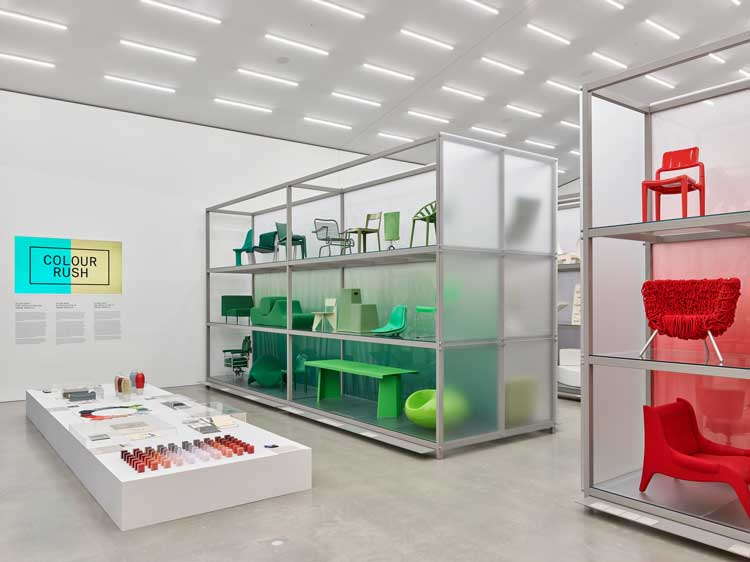
Installation view, Colour Rush! Installation by Sabine Marcelis, Vitra Schaudepot. © Vitra Design Museum. Photo: Mark Niedermann. © VG Bild-Kunst, Bonn 2022.
What I also realised in doing that is that once you strip away historical meaning from these objects, and you see them placed together, categorised by colour, it’s calmer on the eye because you see a sea of a singular colour, and it allows you to zoom in on the materiality, or how a particular colour is applied. Is it in the object? Is it on the object? How is this object made? What is the process? What is the material? And that is obviously what I’m interested in. I think the way that it is presented now allows other people to also zoom in on those aspects of the pieces.
NH: Would you like to highlight any particular objects in the installation?
SM: What’s interesting is that there is an area of objects without colour. Those are very interesting as the opposite to everything else being presented. When you have a void of colour, what’s left? What are you looking at? What does that material do? Is it reflecting its surroundings? Can you look completely through it? Also, what I really loved about working on that exhibition is that there is also a section that showcases how designers work with their own colour theory. So, you have Verner Panton, Le Corbusier, Hella Jongerius, all their colour theories presented on a plinth, and also a bit of a showcase of how we as an industry try to rationalise colour – you have the RAL colour system, Pantone and NCS, different systems of categorising how you can apply colour.
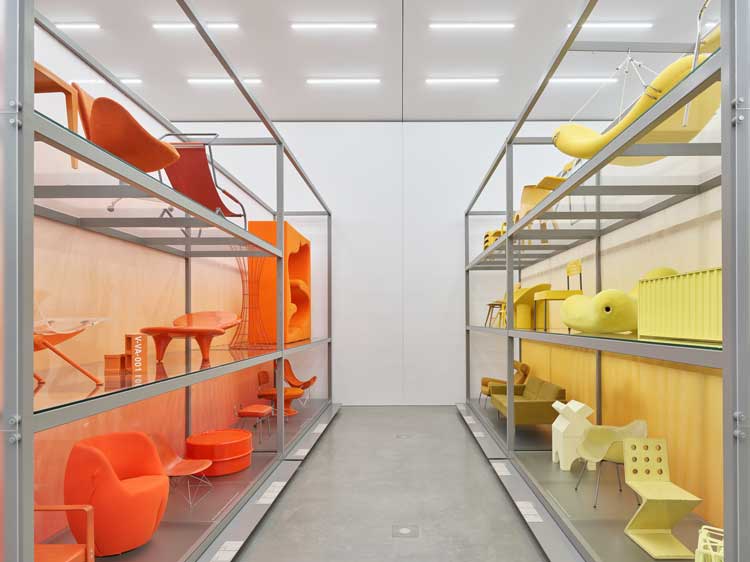
Installation view, Colour Rush! Installation by Sabine Marcelis, Vitra Schaudepot. © Vitra Design Museum. Photo: Mark Niedermann. © VG Bild-Kunst, Bonn 2022.
I also wanted to add something to that, how I work with colour. So, there is a collection of 40, if I remember correctly, resin samples, and it really shows what happens when you add black to a colour, or when you add white to a colour, or when you saturate colour or take it away, so what happens with colour within a material, and then how different it looks when you polish the exterior or you make the exterior matte. Whereas some of the other designers had their colour theory where you’re really understanding it through an application of colour, such as painting on top of a surface, I think my contribution to that is showcasing how much a material has influence on colour as well.
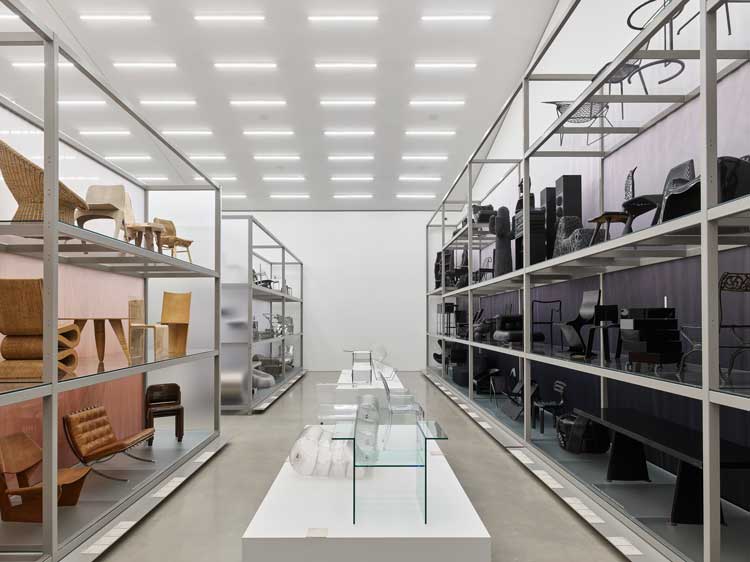
Installation view, Colour Rush! Installation by Sabine Marcelis, Vitra Schaudepot. © Vitra Design Museum. Photo: Mark Niedermann. © VG Bild-Kunst, Bonn 2022.
NH: Can you talk about your own work in the Vitra collection?
SM: Yes, two of my objects are in the Vitra collection. The Candy Cube is one of my earliest works. The first one was produced eight and a half years ago. It very much embodies how I like to work because it is the simplest, stripped-back form and shape that you can imagine, just a cube, but it has something that is very attractive, because of the treatment of the material. It is cast in a singular cast, so there are no seams, and because there is this slight translucency, the material gets thinner on the edges, so the light falls through it a bit more and it gives a glowing edge effect to it. Then the high polish of it gives it another dimension. It has something to it that is more special than just a cube because of its material, but also, because it’s just a cube, you see the material more. I like to play with that duality that form should highlight the material and not act as a decorative, complicated distractor of material.
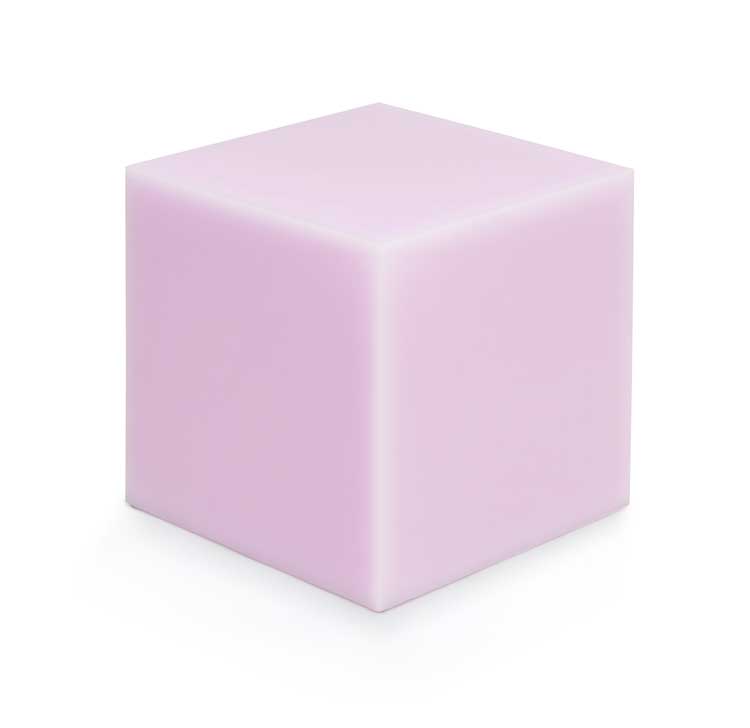
Sabine Marcelis, Candy Cube, 2014. Courtesy of Studio Sabine Marcelis.
NH: That’s fascinating. What do you hope to do next in your practice?
SM: I think the beauty of how I work is that I am not stuck to a specific scale. It can be objects. It can be a collectable design that is a place in a home or in a museum or an installation and then maybe even applied directly within architecture. I love that I can dance around all those different categories. I have a big collection coming out with Ikea in February, which was very much consumer-goods focused, and I learned a lot from that. But I also feel I need to take a little bit of a break from that way of thinking again. And following the London project, I had the opportunity to make a really big, more like a public art installation, in Saudi Arabia, which was also very much working with its surroundings. It’s set in the desert, working with the sunlight during the day and then transforming the object with an internal light source in the evening. I really enjoy those sorts of projects. At the moment, we are working on a large-scale public artwork in America. I’m very interested in creating pieces for the public that correspond with their surroundings, and that informs the work as well.
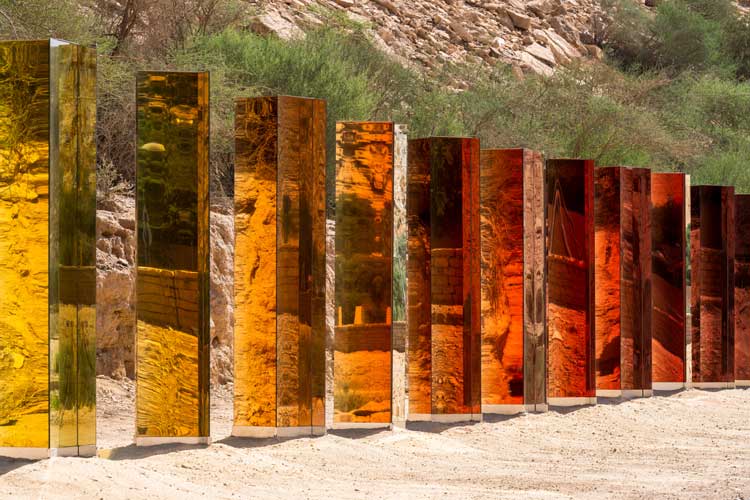
Sabine Marcelis, Light Horizon, installation view, Noor Riyadh 2022. 11 coloured, 2-way mirrored glass columns. Photo: Ruben P Bescos.
NH: It is nice to hear that you are engaged with making work in public spaces. That’s very meaningful for people. Would you like to add anything?
SM: I’m very happy that the Vitra exhibition has been extended for another year. It will now be there until May 2024.
• Colour Rush! An installation by Sabine Marcelis is on display at the Vitra Schaudepot, Weil am Rhein, Germany, until 12 May 2024.